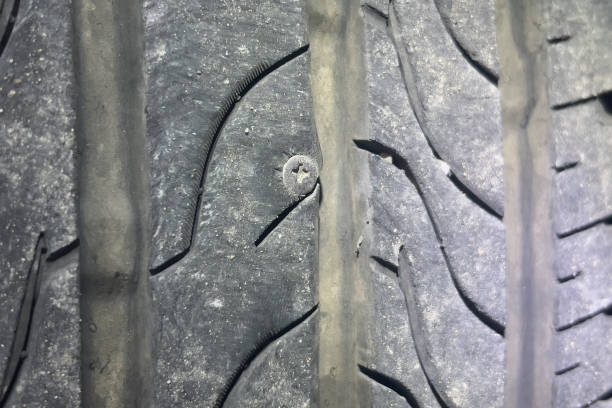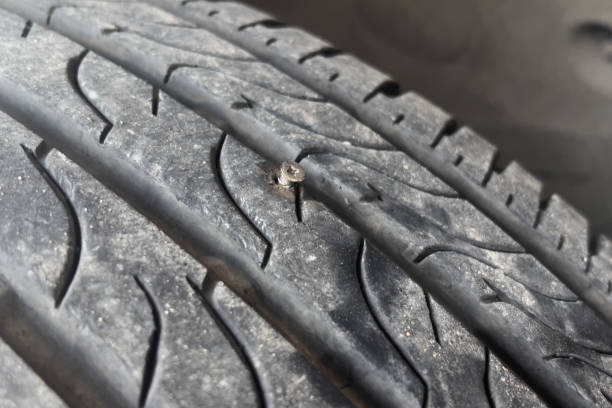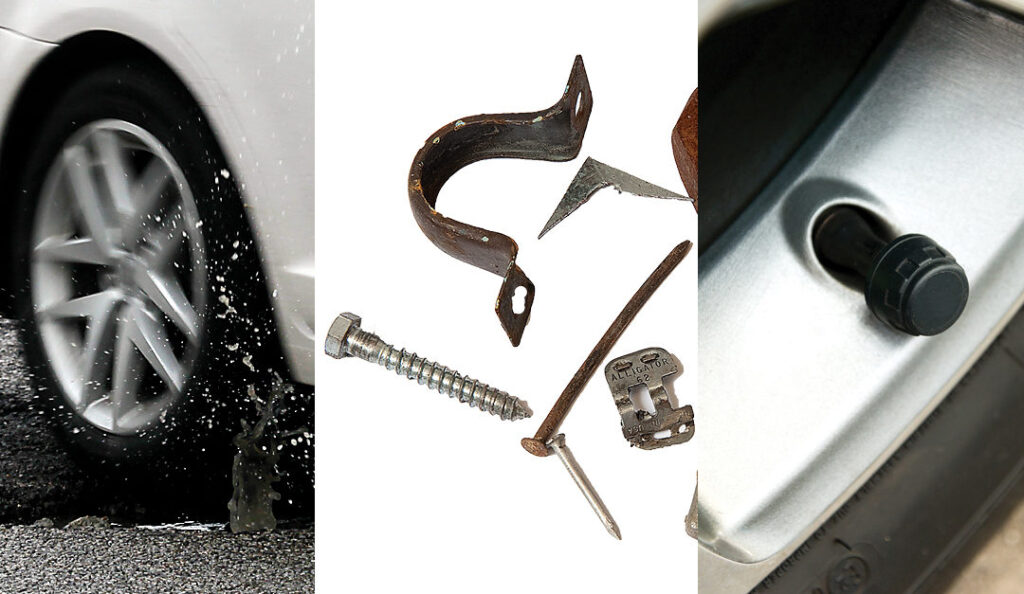To fix a slow leak in a tire, locate the puncture and use a tire repair kit to seal it. Ensure the tire is properly inflated after the repair.
A slow tire leak can be a nuisance and potentially dangerous if left unaddressed. Identifying and fixing the issue promptly can save you from unexpected flat tires and improve your vehicle’s safety. Slow leaks often stem from small punctures, valve stem issues, or bead leaks.
Equipped with the right tools and knowledge, you can easily handle minor tire repairs at home. This guide will help you identify the source of the leak and provide step-by-step instructions to fix it, ensuring your tire remains in good condition and your drives stay smooth and safe.
Identifying A Slow Tire Leak
Finding a slow tire leak can save you trouble. It helps avoid tire damage. You can identify a slow leak using simple methods. Here are some tips to get you started.
Visual Inspection Tips
First, look at your tire closely. Check for any visible punctures. Look for nails, screws, or sharp objects. Also, examine the tire tread. Uneven tread wear can indicate a problem.
Don’t forget to inspect the valve stem. A damaged valve stem can cause a slow leak. Lastly, look for cracks or splits on the tire sidewall.
Using Soap Water For Leak Detection
You can use soapy water to find the leak. Mix water with dish soap in a spray bottle. Spray the mixture on the tire. Focus on the tread, valve stem, and sidewall.
Watch for bubbles forming. Bubbles indicate air escaping from the tire. Mark the spot with chalk or tape. Now you know where the leak is.
| Method | Steps |
|---|---|
| Visual Inspection |
|
| Soap Water |
|
By following these tips, you can identify a slow tire leak. This will help keep your tires in good condition. Always check your tires regularly to ensure safety.

Essential Tools For Tire Leak Repair
Fixing a slow leak in a tire requires specific tools. These tools make the job easier and more efficient. Below are the essential tools you need for tire leak repair.
Patch Kits And Plugs
Patch kits are crucial for fixing tire leaks. They include rubber patches and strong adhesive. You can use these to cover holes in your tire. Plugs are another option. They fill in the puncture and seal the leak.
Patch kits are easy to use. Follow the instructions provided. Clean the area around the leak first. Apply the patch with the adhesive. Press firmly to ensure it sticks well.
Tire plugs work differently. Insert the plug into the puncture hole. Use a plug tool for this. Pull the plug tool out, leaving the plug in the tire. Trim the excess plug material.
Air Compressors And Pressure Gauges
Air compressors are essential for inflating your tire. They make the job quick and easy. Portable air compressors are available. You can keep one in your car for emergencies.
Pressure gauges help you check the tire pressure. Proper tire pressure is important for safety. Use the gauge to measure the tire pressure. Compare it to the recommended pressure for your vehicle.
Here is a simple table to understand the use of these tools:
| Tool | Purpose |
|---|---|
| Patch Kits | Cover holes with rubber patches |
| Tire Plugs | Fill and seal punctures |
| Air Compressors | Inflate the tire |
| Pressure Gauges | Measure tire pressure |
Having these tools handy can save you time and trouble. Keep them in your car for unexpected tire leaks. This ensures you are always prepared for tire emergencies.
Temporary Fixes On The Go
Dealing with a slow leak in your tire can be frustrating, especially when you’re on the go. While a permanent repair is perfect, sometimes you need a quick fix to get you back on the road. Below are some effective temporary fixes to help you manage a slow tire leak until you can get a permanent solution.
Sealants For Immediate Relief
Tire sealants are a quick and easy solution for a slow leak. These products can be found at most auto stores and are simple to use.
To apply a tire sealant:
- Remove the cap from the tire valve.
- Attach the sealant nozzle to the valve.
- Squeeze the sealant into the tire.
- Reinflate the tire to the recommended pressure.
The sealant will fill the hole and stop the leak, giving you immediate relief. This fix can last for a few days or weeks, depending on the severity of the leak.
Inflators: Quick Air Top-up
A portable tire inflator can help you quickly add air to a leaking tire. These devices are compact and easy to carry in your car.
Steps to use a tire inflator:
- Plug the inflator into your car’s power outlet.
- Attach the hose to the tire valve.
- Set the desired pressure on the inflator.
- Turn on the inflator and wait until the tire is filled.
This method won’t fix the leak but will give you enough air to reach the nearest repair shop.
| Method | Pros | Cons |
|---|---|---|
| Tire Sealants | Quick and easy, provides immediate relief | Temporary, not suitable for large leaks |
| Portable Inflators | Compact, easy to use, quick air top-up | Doesn’t fix the leak, only adds air |
Permanent Repair Techniques
Fixing a slow tire leak is essential for safety. Permanent repair techniques ensure your tire remains reliable. Two popular methods are applying a tire patch and professional plug installation. Both methods seal the leak effectively.
Applying A Tire Patch
A tire patch is a strong solution. It seals the hole from inside the tire. Here are the steps:
- Remove the tire from the vehicle.
- Locate the puncture on the inside.
- Clean the area around the hole.
- Apply rubber cement to the cleaned area.
- Press the patch firmly onto the cemented area.
- Allow the cement to dry completely.
A tire patch is durable and long-lasting. It works well for small punctures.
Professional Plug Installation
A professional plug is another effective method. It involves inserting a plug into the puncture.
| Step | Description |
|---|---|
| 1 | Locate the puncture on the tire. |
| 2 | Use a reamer to clean the hole. |
| 3 | Insert the plug using a plug tool. |
| 4 | Trim the excess plug material. |
Professional plug installation is quick and effective. It works best for larger punctures.
Both methods ensure your tire remains in good condition. Always choose a method that suits the size of the puncture.
Preventative Measures To Avoid Future Leaks
A slow tire leak can be frustrating and dangerous. Prevention is key to avoid unexpected tire issues. Regular checks and good practices keep your tires in top shape.
Regular Tire Maintenance
Regular maintenance is vital for tire health. Inspect your tires weekly for any visible damage. Look for nails, screws, or any sharp objects. Remove debris to prevent punctures.
Rotate your tires every 6,000 to 8,000 miles. Rotation ensures even wear and extends tire life. Balanced tires offer a smooth ride and reduce the risk of leaks.
Proper Tire Inflation Practices
Keep your tires properly inflated. Under-inflated tires can cause slow leaks and poor fuel efficiency. Over-inflated tires increase the risk of a blowout.
Use a reliable tire gauge to check pressure monthly. Follow the manufacturer’s recommended PSI for your vehicle. Check tire pressure when tires are cold for accurate readings.
Consider using nitrogen instead of air for tire inflation. Nitrogen maintains pressure longer and reduces the risk of leaks. Many tire shops offer nitrogen inflation services.
| Maintenance Task | Frequency |
|---|---|
| Inspect Tires | Weekly |
| Rotate Tires | Every 6,000 – 8,000 miles |
| Check Tire Pressure | Monthly |
Following these preventative measures helps maintain tire health. Regular maintenance and proper inflation reduce the chances of slow leaks. Keep your tires in good condition for a safer ride.

When To Seek Professional Help
Fixing a slow leak in a tire can sometimes be tricky. DIY methods might not always work. It is important to know when to seek professional help. This ensures your safety on the road.
Limitations Of Diy Methods
DIY methods can be great for quick fixes. But they have limitations. Here are some common issues you might face:
- Temporary Fixes: DIY methods often provide temporary solutions. They may not hold up for long drives.
- Incomplete Repairs: You might miss the exact spot of the leak. This can lead to incomplete repairs.
- Lack of Proper Tools: Specialized tools are often needed. DIY kits might not have these.
- Safety Concerns: Improperly fixed tires can be dangerous. They can lead to accidents.
Finding A Trusted Mechanic
Once you decide to seek professional help, finding a trusted mechanic is crucial. Here are some tips to help you:
| Criteria | Details |
|---|---|
| Reputation | Check online reviews and ask for recommendations. |
| Certifications | Ensure the mechanic is certified by recognized bodies. |
| Experience | Look for mechanics with years of experience. |
| Transparency | Ask for detailed quotes and explanations for repairs. |
Choosing the right mechanic ensures the leak is fixed correctly. This keeps you safe and your car in good condition.

Frequently Asked Questions
Can A Slow Tire Leak Be Fixed?
Yes, a slow tire leak can be fixed. Use a tire repair kit or visit a professional mechanic for help. Regular maintenance prevents future leaks.
What To Do If Tire Is Slowly Deflating?
Check for visible punctures or debris. Inflate the tire to the recommended pressure. Use a tire sealant for minor leaks. Visit a professional mechanic for further inspection and repair. Regularly monitor tire pressure to prevent future issues.
How Much Does It Cost To Fix A Slow Leak In A Tire?
Fixing a slow leak in a tire typically costs between $10 and $30, depending on the repair shop.
Can I Use Tire Sealant For A Slow Leak?
Yes, you can use tire sealant for a slow leak. It provides a temporary fix and extends tire life.
How Can I Identify A Slow Leak In My Tire?
Check for low tire pressure frequently. Use soapy water to find bubbles, which indicate a leak.
Conclusion
Fixing a slow tire leak is simple with the right steps. Regularly check your tires for punctures or damage. Use a tire sealant or patch kit for quick repairs. Keeping your tires in good condition ensures safety and extends tire life.
Follow these tips to maintain your vehicle’s performance.





















